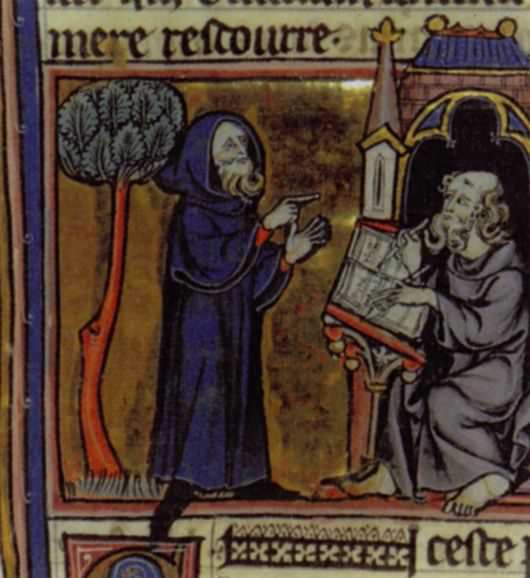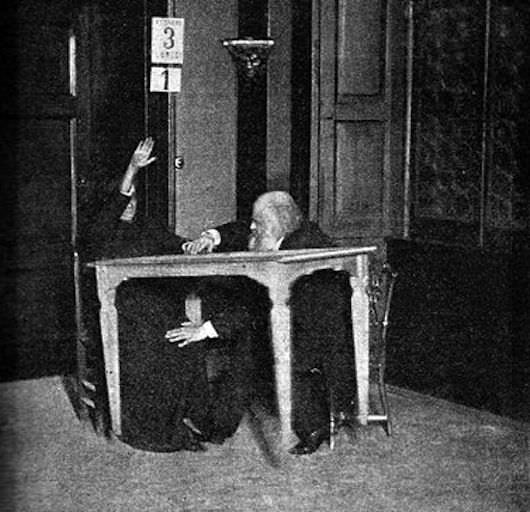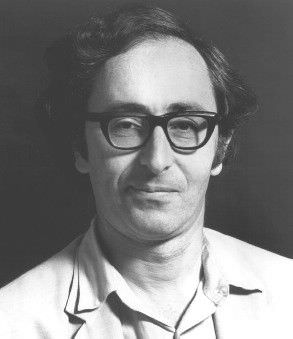The Carrie Phenomenon: A Brief History of Telekinesis
“Extraordinary claims require extraordinary proof.” – Marcello Truzzi, the founding co-chairman of the Committee for the Scientific Investigation of Claims of the Paranormal and the director of the Center for Scientific Anomalies Research.
Covered in pig’s blood, Carrie surveys the most terrifying scene imaginable—a room full of cackling high schoolers. And they’re all laughing at her. It’s one of the most famous scenes in horror film history, to be relived anew in theaters around the country tonight, the titular telekinetic now played by Chloë Grace Moretz. Filled with rage, and more importantly, her mind-over-matter powers, Carrie lays waste to her tormentors.
While there have been movie characters with telekinetic powers before and after (Famke Janssen’s Jean Grey from the X-Men films comes to mind), there is something so purely terrifying about Stephen King’s creation. Perhaps it’s that, unlike Grey, Carrie appears to be just a normal American teenager, the least likely person imaginable to possess supernatural powers. But where did this idea of telekinetic powers come from? Could a person really move things with their mind? And how would that even be possible?

The Original Telekinetics
Historical, religious, mythological, and fictional characters have been moving things with their mind for millennia. Take Shakuni, for example. This key character in the Sanskrit epic “Mahabharata” telekinetically manipulates the dice in a crucial game to alter the outcome in his favor, kicking off the main plot of one of two the major Sanskrit epics of ancient India, as well as the Hindu age of Kali Yuga. Perhaps the first telekinetic, Shakuni reshaped history with his mind back in 400 BC.
And then there’s the most famous telekinetic of them all—Jesus. What was Jesus doing in the Bible if not using telekinesis to turn water into wine, heal the sick, and change a little bit of food into a lot? It's probably a good time to mention that telekinesis, later known as psychokinesis (PK), is an umbrella term for a slew of special abilities that include biological healing and the transmutation of matter, two abilities Jesus displayed in the above examples. Also bundled under the umbrella term psychokinesis is supernatural healing, which sounds a lot like what Jesus was doing when he brought Lazarus back from the dead.
Long before there was Gandalf, there was the telekinetic wizard Merlin, from the legend of King Arthur. According to the Arthurian legend of the 12th century, Merlin’s telekinetic powers were so abundant he sailed through the ocean in a glass house and, to really lay his telekinetic powers on thick, transported Stonehenge across the Irish Sea from Ireland to England.

From Russia With Levitation
Although telekinesis had intrigued people for centuries, it really became a phenomenon in the late 19th century. The term itself was coined by Russian psychical researcher Alexander N. Aksakov. Aksakov got jazzed up by the works of Emanuel Swedenborg, a Swedish scientist who allegedly had psychic abilities. Aksakov was specifically interested in the physical manifestations of mediumship (people who can commune with spirits).
By the late 1860s, Askakov had become famous as one of the organizers of the first séances in Russia, and eventually became known for his study of the British medium Mme. D’Esperance (born Elizabeth Hope), who Askakov believed was a legitimate medium. D’Esperance traveled throughout Europe conducting séances, claiming she had a host of telekinetic powers, including automatic writing (producing writing from a spiritual source without conscious awareness of the content), ectoplasm (producing a gauze-like substance from orifices in her body that spirits could then drape over their nonphysical bodies in order to interact with the physical universe), and good old fashioned telekinetic table-turning.
Unfortunately for Askakov, damning evidence of fraud undid most D’Esperance's claims, as it did for many other mediums and their admirers. In one instance, D’Esperance was exposed in 1880 by a sitter at one of her séances portraying a spirited name “Yohlande.” Eusapia Palladino, an Italian medium and another subject of study for Askakov, claimed to be able, among other abilities, levitate and telekinetically move objects. She too was exposed as a fraud by investigators, including the British Society for Psychical Research in England and the Harvard psychologist Hugo Munstenberg in America, when she was found to be kicking objects across the room and “levitating” tables with her foot.
![Spirit photography hoaxer Édouard Isidore Buguet[19] (1840-1901) of France fakes telekinesis in this 1875 cabinet card photograph titled Fluidic Effect.](https://www.motionpictures.org/wp-content/uploads/2013/10/Edouard-Isidore-Buguet-PK-spirit-photographer.jpg) Master magician and escape artist Harry Houdini hammered home one of the final nails in the coffin for telekinetic mediums. Houdini’s book “Miracle Mongers and Their Methods” is a detailed excoriation of their claims of supernatural powers.
Master magician and escape artist Harry Houdini hammered home one of the final nails in the coffin for telekinetic mediums. Houdini’s book “Miracle Mongers and Their Methods” is a detailed excoriation of their claims of supernatural powers.
Telekinetics Gets Scientific
Telekinesis went from the realm of the supernatural—objects being manipulated by spirits, angels, demons, ghosts and other such forces—into the purview of science. In the 1930s American parapsychologist J.B. Rhine began conducting experiments, stripping away all the theatrics and voodoo associated with telekinesis and reducing it to its most simple terms in order to test it in a laboratory setting. In 1934, a young gambler came to Rhine and told him he could effect dice with his mind. The results of Rhine’s tests on the young man’s ability were surprising, and encouraging.
Rhine went on to conduct further experiments to see whether a subject really could influence the outcome of tossed dice. By the end of 1941, he had tested more than 650,000 experimental die throws, with the results suggesting that psychokinesis was, indeed, possible. Although the results of Rhine’s experiments were mixed, and the effects witnessed were small, he was far from being alone in thinking people might be able to manipulate objects with their minds.
The PEAR Lab, the US Army & the Man Who Wrote "Jurassic Park"
Robert M. Schoch, a Ph.D. in geology and geophysics from Yale and an associate professor of Natural Science at a unit of Boston University, has written about his belief in psychokinesis. His book “The Parapsychology Revolution: A Concise Anthology” takes a deep dive on the subject, with evidence pulled from the Princeton Engineering Anomalies Research Lab (PEAR).
PEAR conducted studies on extrasensory perception and psychokinesis starting in 1979. The lab’s founder, Robert G. Jahn, told The New York Times in 2007, “If people don’t believe us after all the results we’ve produced, then they never will.”
The Harvard Crimson reported on the origin of the PEAR lab and some of it’s more famous studies. The lab came into being thanks to a curious Princeton undergraduate’s senior thesis in the late 1970s. Using a random events generator (REG), she tested whether a subject could use psychokinesis (PK is how telekinesis is described in all scientific papers and reports, and is how we will refer to it from here on out) to produce an unambiguously non-random outcome. The REG was basically a coin-tossing machine, and the undergrad’s goal was to see if the subject operating the REG could mentally manipulate the machine into tossing more heads than tails (or tails than heads). The findings of this experiment suggested a small difference between those REG trials that involved a human participant and those that did not. Small, but statistically significant.
The student’s thesis advisor was Robert G. Jahn, then the dean of the Princeton School of Engineering and Applied Sciences. He was so impressed by her success that he included the study of psychokinesis as one of his research areas, eventually founding the PEAR lab. One of PEAR’s landmark studies was the experiment with the billiard pools. Jahn set up a device that dropped 9,000 billiard balls into a series of 19 cartons. When no human being was present during the experiment, the balls consistently dropped in a cascading effect, with the center carton getting the most balls while the cartons to its left and right got progressively fewer. When a human participant was asked to try to psychically alter the machine, the bulk of the balls shifted right of center.
In 1984, the US Army Research Institute asked the National Academy of Sciences to form a scientific panel to look into evidence from 130 years of parapsychology research. The army was interested in the potential military applications of psychokinesis (it would be valuable to have somebody who could jam or disrupt an enemy’s weapons remotely). There were people in the military who believed in psychokenisis, and who made visits to the PEAR lab.
In 1988, prolific author (and former doctor) Michael Crichton claimed to have had a successful experience with psychokinesis at a spoon bending party in his autobiography Travels. “The party began: a hundred people selecting spoons and saying, ‘Will you bend?’ and tossing them back in the pile if the feeling wasn’t right…rubbing her spoon, Anne-Marie said, ‘I don’t think this is going to work. This is silly. I just don’t see how it can work.’ I looked down at her hands. Her spoon was bending.”
There have been plenty of credible individuals in the public sphere who claim to have witnessed psychokinesis first hand. French biologist Remy Chauvin, author Michael Talbot, and Dean Radin, senior scientist at the Institute of Noetic Sciences, to name a few.
But How Could The Mind Move Stuff?
There are two basic metrics researchers use to describe measuring the effects of supposed psychokinetic effects during experiments, Micro-PK and Macro-PK. Micro-PK requires scientific equipment to observe the manipulation of atoms, molecules and subatomic particles. Macro-PK describes any large-scale effect that can be seen with the naked eye.
Haakon Forwald, a Swedish electrical engineer, promoted the idea that a person could manipulate gravitational fields by mentally agitating the atoms and neutrons inside an object. Gerald Feinberg, a Columbia University physicist, futurist and author invented the idea of the tachyon, a theoretical particle that moves faster than the speed of light and could, possibly, explain psychokinesis.

In 1991 Nobel Prize laureate Brian Josephon and co-author Fotini Pallikara-Viras proposed that both psychokinesis and telepathy might be explainable using quantum physics. Their scientific paper "Biological Utilization of Quantum Nonlocality" stated that earlier researchers were correct in the conscious and creative mind’s potential to affect the statistical outcomes of quantum phenomena.
Then there is the longstanding notion that our minds are mostly underutilized wonder machines. It is widely believed that we only use roughly ten percent of our brains. This would suggest that the untapped 90 percent is a realm of extrasensory powers and abilities, making it seem as if every human is simply a frustrated X-man.
Neurologist Barry Gordon of John Hopkins School of Medicine told Scientific American that this is simply, irrefutably wrong. “It turns out, though, we use virtually every part of our brain, and that [most of] the brain is active almost all the time.” Summing it up nicely, Gordon told Scientific American, “Let’s put it this way: the brain represents three percent of the body’s weight and uses 20 percent of the body’s energy.”
The Psychokinetic Hall of Fame (Or Shame?)
Mme. D’Esperance and Eusapia Palladino are hardly the only people to have claimed to be psychokinetic. Nina Kulagina, who joined the Red Army at age 14 and served in the tank division during World War II, became internationally known for her psychic abilities during the 1960s. Silent black and white film of her appearing to move objects on a table with her mind were produced during the Cold War. She appeared in the U.S. Defense Intelligence Agency report in 1978.
The Brit Matthew Manning was studied by researchers in England and the United States for his PK abilities in the late 1970s, and claims today he has healing powers.
And then there’s Uri Geller, the Israeli who has made millions of dollars traveling the world bending spoons.
The Critics
The list is long, and includes the above quoted Marcello Truzzi, the mathematics and science writer Martin Gardner, psychology professor Thomas Gilovich, Nobel Prize laureate Richard Feynman, and arguably the most famous American astronomer (among other disciplines) of the 20th century, Carl Sagan. Sagan and Feynman advocated positions that the burden of proof was on the proponents of PK, and cautioned skeptics and proponents alike to seek out better evidence, for or against.
One minor problem with the validity of psychokines is that it would violate some pretty fundamental laws of physics, including the second law of thermodynamics, the conservation of momentum (motion never changes in an isolated collection of objects), and the inverse square law (a specified physical quantity or intensity is inversely proportional to the square of the distance from the source of that physical quantity).
There’s also the problem with the evidence supporting psychokinesis. J.B. Rhine’s research was incapable of being duplicated by other researchers, and many bias errors were found in his methods, a crushing blow to the PK movement considering his research provided the strongest evidence in support of it. The list of biases that pollute research is frustrating for PK proponents, and include cognitive bias (people are susceptible to illusions of PK), experimenter’s bias (when scientists unconsciously affect subjects in experiments), and confirmation bias (the tendency for people to favor information that confirms their beliefs or hypotheses). This doesn’t even include illusory correlation, introspection illusion and magical thinking.
It should also be noted that many individuals who have claimed PK abilities have been either exposed as frauds or refused to participate in challenges that enforced control protocols.
Where Does That Leave Us?
The mind is an incredible organ, regardless of whether it can psychically manipulate objects. There are mind-controlled video games, ongoing (and freakishly effective) studies on mind-to-mind interfacing, and mind-to-machine computers popping up.
But for the really mind-blowing stuff, the best place to see superhuman abilities is still the movie theater. Or, if you're really lucky, your local coffee shop.
Featured Image: Chloë Grace Moretz in Carrie. Courtesy Sony Pictures.



